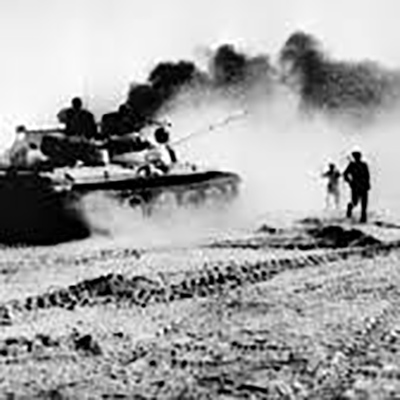Battles
Operation Tavakkol
Mohsen Shir-Muhammad
119 Views
The Iranian Army Ground Force carried out Operation Tavakkol to liberate occupied areas of Khuzestan during the first year of the Iran–Iraq War.
On December 18, 1980, a plan was developed by the Arvand Headquarters to push Iraqi forces back from the eastern banks of the Karun River and liberate the Ahvaz–Mahshahr–Abadan roadways.[1] The Arvand Headquarters had been established earlier on October 16, 1980, by order of the Joint Staff of the Army. Acting under the command of Colonel Hassan-Ali Forouzan, then Commander of the Iranian Gendarmerie, it was responsible for promoting coordination between military forces in southern Khuzestan.[2]
Named Tavakkol, the plan was designed to be executed in two phases. In the first phase, the 37th Armored Brigade was to launch an east-west assault north of the Mahshahr–Abadan axis, targeting the enemy’s forward bridgehead and seizing the Mared Bridge.[3] At the same time, the 301st and 303rd Gendarmerie battalions would secure the brigade’s southern and northern flanks. In the meantime, the 246th Armored Combat Tank Group and units of the Islamic Revolutionary Guard Corps (IRGC), positioned in Sulaymaniyah and Darkhovein, would attack southward along the eastern bank of the Karun River, capturing enemy trench lines. In the second phase, following the relative success of the eastern and northern columns, the 2nd Infantry Brigade of Quchan was to advance from south to north, attacking Iraqi defensive lines at the southern end of the frontline. In addition, the IRGC and local volunteer forces took part in the operation in coordination with the military units. If the eastern bank of the Karun River could be fully liberated, further attacks would be carried out along the western part of the river.[4]
In January 1981, a few days before the operation, the Iranian authorities realized that Iraqi forces had found out about the attack. That is why on January 9th, they launched a heavy artillery barrage along with air strikes on the positions of the deploying units of Arvand Headquarters. In addition to heavy bombardment, significant Iraqi troop movements took place, particularly along the Ahvaz–Khorramshahr axis and reinforcement forces were dispatched to the general area of Khorramshahr–Abadan. These actions strongly suggested that the Iraqis had become aware of the impending Iranian attack in the eastern Karun region. That is why the 3rd Iraqi Army Corps redeployed reserve units from Ahvaz and Basra.[5]
Despite the increased enemy alertness, Operation Tavakkol was launched. At 12:30 AM on January 10, 1981, the 37th Armored Brigade attacked the enemy positions. Initially, the advance went well. However, by 6:30 AM, as daylight broke, the lack of sufficient equipment such as bulldozers and loaders made it impossible to construct protective earthworks. Consequently, several of the brigade’s tanks and bulldozers were hit by Iraqi anti-tank fire. Fresh enemy troops then entered the area, shifting the balance in favor of the Iraq, and making further advance impossible. Although Iranian forces managed to penetrate Iraqi defensive lines and capture several trench lines deep within enemy territory, they were ultimately unable to hold their positions due to heavy enemy pressure and thus the 37th Armored Brigade retreated.[6]
At 1:00 AM, the 246th Armored Combat Tank Group and the IRGC units began backing the 37th Armored Brigade by both direct and indirect fire. One team of this group left its main position in an attempt to advance southward. However, it encountered an enemy minefield and as it lacked the military technicians, the forces failed to clear the mines and were forced to retreat.[7]
The 301st Gendarmerie Battalion also attacked the Iraqi positions and succeeded in capturing part of the enemy line. However, due to the overwhelming superiority of Iraqi troops in the area, they were unable to hold their ground and withdrew to their previous positions by 10:00 AM. Meanwhile, the Irregular Warfare Group organized infiltration patrols along the Mahshahr–Abadan axis, approaching Iraqi positions and inflicting some casualties on the enemy. Despite providing initial fire support for the advancing units, the 22nd Artillery Group struggled to maintain momentum, as the gun barrels of six artillery pieces needed urgent repair or replacement.[8]
In the southern axes, the forces of the 2nd Infantry Brigade of Quchan (Army), along with the volunteer Fadayan-e Eslam Group, made a limited advance in the Fayyaziyeh area. However, after Iraqi reinforcements arrived, they were forced to retreat.[9]
In Operation Tavakkol, air support was supposed to be provided by the Iranian Air Force from Bushehr Air Base.[10] However, four of the ten scheduled sorties were redirected to a different area without coordination with Arvand Headquarters. Later that afternoon, due to heavy cloud cover, no air support could be provided. On January 11th, persistent rain again made air support impossible. Unexpectedly, the Army Aviation (Havanirooz) support on the day of the attack also proved largely ineffective despite deploying 13 helicopters and conducting 38 sorties.[11]
In total, Iranian forces suffered 95 martyrs and 326 wounded in the operation. Moreover, 66 people went missing, and the enemy took 152 prisoners of war. Equipment losses included 24 tanks, 7 armored personnel carriers, and one TOW missile launcher vehicle.[12]
By January 11, 1981, following the unsuccessful Operation Tavakkol, the situation in the Abadan–Mahshahr region once again deteriorated, as both sides resumed artillery exchanges.[13]
[1] Sadeqi-goya, Nejatali, Defa az Abadan dar Sale Avale Jange Tahmili (Defending Abadan in the First Year of the Imposed War), Tehran, Iran Sabz, 1391, p. 173; Dorudian, Muhammad, Tajziye va Tahlile Jange Iran va Araq – Bazyabi Sobat (Analysis of the Iran-Iraq War: Restoring Stability), Vol. 2, Tehran, Markaze Motaleat va Tahqiqate Jang, 1378, p. 115.
[2] Ranjbar, Seyfolah, Niruhaye Entezami va Jang (Security Forces and the War), Tehran, Entesharate Eslami, 1386, p. 87; Sarvari, Rouhollah va Abolqasem Javdani, Amaliate Thamen al-Aemmah (as) (Operation Thamen al-Aemmah (as)), Tehran, AJA, 1390, p. 73.
[3] Saremi, Majid, Tip 37 Zerehi dar Amaliate Thamen al-Aemmah (as) (37th Armored Brigade in Operation Thamen al-Aemmah (as)), Tehran, Iran Sabz, 1389, p. 31.
[4] Bani-Lohi, Seyyed Ali va Digaran, Nabardhaye Sharqe Karun be Revayate Farmandehan (Battles East of Karun as Told by the Commanders), Tehran, Markaze Motaleat va Tahqiqate Jange Sepah, 1387, p. 135; Hussaini, Seyyed Yaqoub, Nabardhaye Mantaqe Khorramshahr va Abadan dar Sale Avale Jange Tahmili (Battles in Khorramshahr and Abadan in the First Year of the Imposed War), Tehran, Iran Sabz, 1396, Pp. 350, 368.
[5] Ibid., p. 185.
[6] Ibid., Pp. 370, 371.
[7] Ibid., p. 368.
[8] Ibid., p. 371.
[9] Raminnejad, Ramin, Tarikhe Lashkare Khorasan (History of the Khorasan Division), Vol. 2, Mashhad, Ahange Ghalam, 1391, p. 69; Ibid., p. 370.
[10] Namaki, Alireza, Tarikhe Nabardhaye Havayie – Amaliate Morvarid va Nasr Nabardhaye Havayie Azar va Deymah 59 (History of Aerial Battles – Operations Morvarid and Nasr: Air Battles in December 1980 and January 1981), Vol. 6, Tehran, Markaze Entesharate Rahbordiye Nahaja, 1396, p. 375.
[11] Ibid., Pp. 371, 372; Jafari, Mojtaba, Atlase Nabardhaye Mandegar (Atlas of Lasting Battles), Tehran, Soore Sabz, 35th ed., 1393, p. 40.
[12] Ibid., Pp. 370–373.
[13] Ibid., p. 373.





